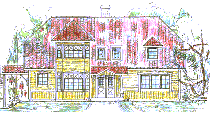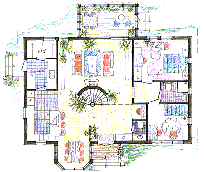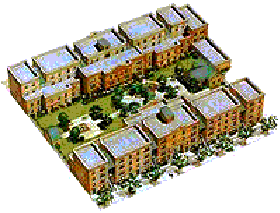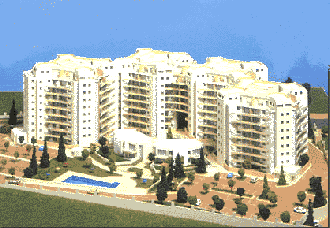1 OR 2 NOTES
ON FACING, SITTING
AND MING TANG
Case studies I-V
What to do
if you find the Facing side oriented away from the interior lay-out of
active rooms. Here you will find some of the situations you may encounter
and how to solve them.
Situation I
Most
desired situation seen from the perspective of Feng Shui. Human design is
in full accordance with environmental Qi. The active rooms are in the yang
side, the passive rooms are in the yin side. People tap into the
appropriate Qi.

Remedy:
Much
depends on the Flying Star chart of the house, but in essence this
situation is what we look for in any house. We can locate the bedrooms to
the architectural back of the house, as well as the storage rooms. The
more active rooms, like the living, family room or our home office should
be located to the architectural front in this example.
Situation II
The
exterior Ming Tang is still in the architectural front, but the active
rooms are now oriented to the back of the house. The passive rooms will be
then wrongly to the architectural front. Modern architecture, provided for
comfort, i.e. providing privacy and comfort of a back yard view.

This
villa has a definite – well defined - Ming Tang to the architectural
front.
The floorplan shows a spacious entrance where Qi can be fully admitted
into the house. Even though the living room is situated into the back, it
cannot justify Facing side to be to the architectural back.


Remedy:
Since the basic situation shows a house that still asks us to orient our
activities towards the architectural front, we should consider to change
this situation into the design shown under A.
Situation III
Both
exterior and interior Ming Tang are away from the architectural front. The
Facing side is to the back of the house, with the active quarters to the
back as well. Most likely this situation is forced upon the house by the
environment, where there may still be many factors for the Facing side to
be at the architectural front, but closer examination of environmental
features showed us the Facing side must be to the architectural back. Also
most common for apartment units, in which case this situation was forced
upon us by architectural design.

Here
is a compound with apartments, all factually oriented with the ship’s bow
toward architectural front, with bedrooms and kitchen to the architectural
front also.
The living rooms are at the architectural back, facing the central
courtyard.
This situation justifies for the house Facing to be at the architectural
back.
This ship is heading backward.
Remedy:
 Again,
the passive rooms will be to the architectural front, but here at least
the exterior and interior Ming Tang are connected. In case this situation
applies to a ground level house, try to arrange the landscaping at the
architectural back and - the flying star chart allowing - use the back
door. Again,
the passive rooms will be to the architectural front, but here at least
the exterior and interior Ming Tang are connected. In case this situation
applies to a ground level house, try to arrange the landscaping at the
architectural back and - the flying star chart allowing - use the back
door.
Passive rooms like bedrooms to the architectural front as shown here, are
not only less inviting, people will hardly be able to rest here, for
reason that Qi is too active to permit tranquility.
Study
the flying star chart to see what can be done here.
Situation IV
This
could be a situation where there is a road to the architectural front, but
all other features are pointing well to the exterior Ming Tang – the
Facing side – being at the architectural back of the house. To the back
there could be lively landscaping, water, sloping grounds and other yang
factors.

Remedy:
Here we should do effort to change the interior, so as to have the
interior Ming Tang coincide with the exterior Ming Tang. Take active rooms
to the architectural back.
Were
we to add floors, these diagrams could become a lot more complicated.
Also, the situation for condominiums, apartment buildings and apartment
units can become rather complicated.
Situation V
Although it may sound odd to most people, in all above shown examples, the
main door played a role of much less importance than one would expect.
The main door remains quite important in assessing the type of Qi that
will be admitted into the house, but you could encounter the following
situation easily, e.g. in case of a large apartment building. Due to
interior hallways, all factors could be oriented towards a certain
direction, the main door however oriented away from this.


Condominium resembling the Chinese character Gōng (工)
meaning work.
Clearly the Ming Tang to the building is to its architectural front,
however individual apartments arranged so that each one of them allows its
own view. It is this view that most probable has a balcony and sliding
doors and needs to be thus taken as an apartment unit’s typical Facing
side.
Clearly then, the main door will be away from this Facing (unit’s exterior
Ming Tang) and still quite important to assess the type of Qi entering
through the Palace with the door.
Also,
consider the condominium’s flying star chart to determine in which section
the unit is.

Condominium, to an extent resembling the Chinese character Shān (山)
meaning mountain.

Back |
Table of content |
Next |